Perceived Exhaustion?
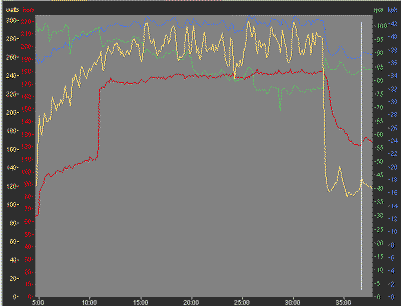
WKO+ Screenshot Escalating Interval
Challenges your RPE like you wouldn't believe
Perceived Reality...
Who, or what, when you're banging out that final
lung-busting interval, decides when enough is enough? Is it your
legs, your heart, your lungs or your head? We'll let's have a discussion
about it, look at some "peer reviewed" material, present a little
empirical evidence, then let you come to your own conclusions! It's a bit
long; but stick with it!
The knowledge in this factsheet really can be a game changer for you and the way you view your training and competition. Not immediately, it won't change your next ride. But over the coming weeks and months, especially through the winter, it will, without doubt, make you a fitter, faster, stronger rider.
A bit heavy at first, and long, but please stick with it. It could turn you in to a champion...
Measuring Effort
There are many ways to objectively and subjectively measure the effort
you put in to your training sessions. Here are just a few...
| ▼ | Watts | Power ~ the Gold Standard? |
| ▼ | BPM | Heart Rate ~ time lagged indicator |
| ▼ | kph & mph | Speed ~ Better than Heart Rate? Sometimes! |
| ▼ | mmol/L | Blood Lactate Analysis ~ Messy, not very practical |
| ▼ | w/kg | Power to Weight ~ needs a power meter |
| ▼ | RPE Number | Perception ~ How hard you think you're trying? |
Here's a more in depth description of the above parameters with their pro's and con's. As you may of guessed from the title of this factsheet, here we're going to concentrate on, perception.
RPE ~ Rate of Perceived Exertion
Our bespoke Performance
Programmes are tailored to the individual athletes that honour
us with their custom, and trust us to work with them in meeting their
sporting objectives.
Some choose power as their metric of choice, while some use heart rate to indicate their physiological state. Others use nothing but their suffering, but that doesn't make them any less adept at improving their fitness and performance. After all, Merckx and Hinault never had power meters or heart rate monitors.
For all the people that come to visit us or use our services, I designate that the priority, above all else, is to finish the prescribed, timed, interval session no matter what the "numbers" are on their display metric of choice.
In fact for some sessions I even advocate covering up their display and "riding on feel" to get a better understanding of how their body works and the messages and sensations experienced. The objective is to get to the end of the session and let the power meter validate their performance, not drive or limit it.
To help, I provide our own subjective Physical Exertion Scale (the Panel of Pain) that maps the objective "industry standard" performance zones against easily defined, perceptions of stress.

click the graphic for a full size view
So what drives this performance "judgement call" and who, or what, decides when enough is enough? First we need to understand what we think we know about how our own individual, highly personalised, subjective arbiter of pain, works.
Identifying Exertion Levels
In the late nineteenth century, Italian, Angelo Mosso,
proposed that
fatigue was a self-protection mechanism, initiated by the brain, to
protect the body from effort induced, physical self-harm.
In the 1920's Englishman, Archibald Hill and his team, countered Mosso's proposals and suggested that fatigue was due to biomechanical changes in the working muscles. They proposed that fatigue was due to the energy tanks running dry, the working muscles changing their ph balance, thus causing "fatigue". (See Lactate Myth Busters as to why this may be).
Hill put forward that fatigue comes from the body's peripheral systems (muscles, heart, lungs, etc.) not the Central Nervous System as pitched by Mosso.
Hill thought it was possible to create a "Peripheral Linear Catastrophe Fatigue Model" which would fit all of us. In other words if we went this hard, for that long, we will fail exactly "here", when the fuel ran out. Just as in a car.
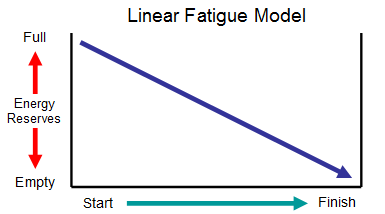
A reasonable exertion, and one to which we can all relate. Because that's exactly how it feels.
Not so! Apart from Hill's grandiose title being a 'mare to remember recent research has suggested there are more ethereal forces at work. It doesn't mean they have any less of a fancy title though.
Our Own Higgs Boson
It's been suggested that we have inside us a built in governor. This governor regulates performance through interconnected conscious and sub-conscious
systems that prevent the body from "suffering the trauma of a homeostasis
disruption". Or in plain English, "it stops us trying that hard,
that we die!
But no one's really found it yet, or can fully demonstrate their theory. There appears to be a "bit" missing. What we do know is that something, somewhere, inside us all, says "enough now". I'm sure you've all experienced it going for that Strava segment, race ending sprint or attacking your mates to the top of your local classic climb.
However, I often find when carrying out Ramp Tests and wVO2max Tests that people can push themselves further when I'm standing next to them, encouraging them to give more.
They'll admit to this themselves. Otherwise they would just do a self-test at home and send me the files for analysis. But they don't, they come along, put themselves under pressure to find that extra few percent that's within us all.
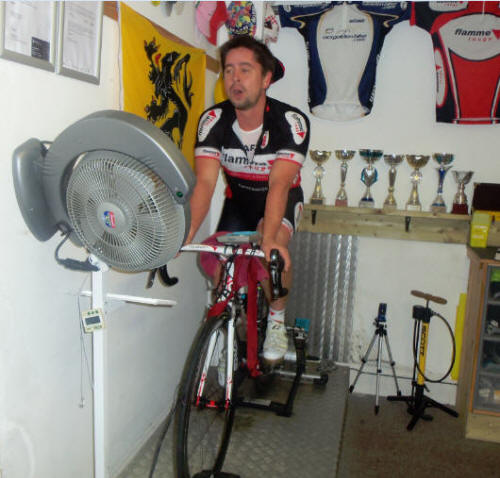
I don't know if they feel they are being judged (they're not) or it's due to having an external focus, rather than an internal one. It's probably easier to over-ride your "negative" inner voice when there's someone shouting "positive" encouragement in to your ear!
Also, when they push, push, push, to the end of the testing protocol, the instant I say "okay, enough", to start the cool down section, most stop, collapse in a slump on the bars, and have to be "encouraged" to keep pedalling to allow the all important post-test blood lactate measurement to be taken.
They quite clearly believe they have emptied the tanks. But when I ask them to ride on slowly, they do so (relatively speaking) quite happily. I then have to tell most of them to "back off" during the cool down as they're going way too hard and start to build lactate again!
Then they ride home! Which in Jersey, usually means hills.
Whatever the reason, everyone appears to dig deeper and find that little bit extra effort when encouraged by external stimulus.
Only recently we've seen British athletes, at the London Olympics, acknowledge that the huge, home crowds made a measurable difference to their performance. These are professional athletes, trained to give their all at every opportunity. So how can that be so? If the crowds weren't there would they give just ninety-nine percent?
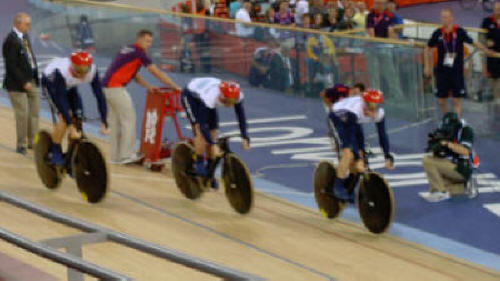
Surely these aren't just platitudes for the home fans. I myself, sat in the velodrome and watched Team GB's Hindes, Kenny and Hoy break the world record in each of their three runs to take the gold medal. Three runs, three world records in three hours! How is that possible?
So what gives? What intrinsic phenomena, triggered by extrinsic stimulation, tells us to go, go harder, or stop?
Research Studies
The people in white coats have carried out many studies in to
the causes of fatigue in cyclists. Cyclists have loads of
studies done on them because the researchers can stand next to them
while they bang out a session on a turbo. Try doing that with a
swimmer, footballer or gymnast!
It is now generally understood that physical exertion, of any sort at any level, always seems to be "voluntarily" ended before we "metabolically damage" ourselves and before ATP levels fall below 50%. So why do we stop when there's 50% fuel left in the tank?
Anticipation Feedback Model
Between 1996 and 2009, various studies took place around the
world to try and understand how our body and mind interlink to determine
a Rate of Perceived Exertion.
This graphic covers a little of the understanding, and theory regarding self-paced exercise. It seems once we have an understanding of how long we have to last (represented by the stopwatch bottom right) we push ourselves, using a combination of sensory feedback and stimulus to make sure we "just" get ourselves to the end of our endeavour (the little man with the STOP sign).
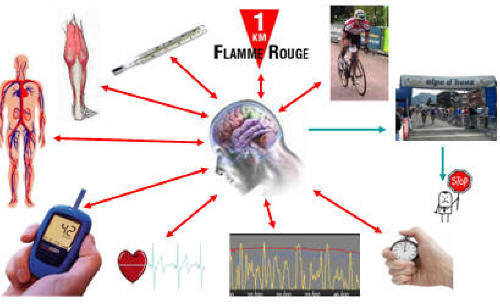
As I mentioned above, I've seen this so many times on the five hundred or so tests I've carried out here in our lab. For me, the theory stacks up. Here's how we/they "think" it works.
Once we know for how long we're expected to last (be it a 4 minute interval, VO2max Test, 10 mile TT, 25 mile TT, mountain climb or 200k super sportive) a combination of experience of similar past endeavours and "afferent peripheral feedback" combine to make sure we "just" get ourselves to the end.
Afferent Peripheral Feedback, is the term used to cover how our body monitors itself through its central nervous system. We're not aware of it happening, so please just accept that it does. Messages and signals are constantly sent to the brain regarding the status of (amongst, many, many others) our...
| ▼ | Muscle & liver glycogen levels | |
| ▼ | Blood lactate levels | |
| ▼ | Blood oxygenation | |
| ▼ | External skin temperature | |
| ▼ | Internal core temperature | |
| ▼ | Muscle & blood hydrogen ion concentration | |
| ▼ | Heart rate and stroke volume | |
| ▼ | Breathing pattern and "capacity" | |
| ▼ | Motivational state, etc, etc, etc... |
The "sensations" above are then logged against a "pre-configured template of experience". The ethereal combination of sensations and experience, almost before we start, determine when we will finish! The above parameters are only a tiny fraction of the total list that we know about, but you get the picture.
The intrinsic monitored sensations, and our experiential template, are constantly mapped against extrinsic factors such as the...
| ▼ | Weather | |
| ▼ | Environment and terrain | |
| ▼ | Distance or time to finish line | |
| ▼ | External competition or judgemental stimulus | |
| ▼ | Visual or audiotorial stimulus | |
| ▼ | Emotional state | |
| ▼ | Time of day, circadian rhythms etc, etc... |
So before we get too far underway our body has already determined a template against which it will measure how hard we're allowed to push ourselves. It then constantly compares our current work rate against this pre-determined template. If we're behind the curve it will allow us to push on; all the while checking to see if it thinks what we are doing is sustainable.
If the sensory input sensations become overwhelming and the actual effort appears to exceed our template's expectations, something, somewhere, backs things off to restore equilibrium and stasis.
Be it the brain, the central nervous system or some other physiological, sub-conscious controller. This constant, big-brother, work-rate feedback model, is the success determinant of our next interval session, workout and/or race performance.
So, for this section of the factsheet it can be seen that fatigue is a conscious sensation derived from sub-conscious stimulus. Our fatigue tolerance is designed to allow us to attain perceived optimum performance without too high a perceived physical price being paid.
In other words, a value compromise has been made on our behalf. Our brain is setting and driving our fatigue perception. We only think we're knackered!

As an example. Whenever you start a "fixed level effort", like the WILT Intervals, it will always seem easy at the start. But as the session progresses, the Rate of Perceived Exertion, even though the wattage has been constant from minute one, appears to slide during the interval until the last minute of the last effort is almost always perceived as maximal exertion.
As you can see above, the dark blue line now marks the effort completion at fifty percent of the energy reserve, not the zero percent as Hill thought.
The light blue line above indicates the brain stimulus, which closely mirrors our RPE. We start off with a high "brain engagement", as all the sensory input data is collated and extrapolated to form an expectation of achievement.
Once that's sorted, we go to "automatic pilot" in the middle and can often ride without looking at heart rate or wattage screens; somehow we just know when it feels right.
As the end draws near we have to concentrate much, much more, to keep our body pushing out power that it previously did without a care in the world. We now have to fight to keep going as the "voices" in our head encouraging us to stop, or back off, get increasingly louder.
It's as though our body has already decided the outcome before we started the effort. As we prepare to set off, our conscious mind is getting ready for the big attack of a cycling King's Gambit, while our sub-conscious is preparing a Sicilian Defence to limit progress.
How Does This Help?
It's getting on the bike with this knowledge, and
manipulating it before it manipulates you, that can help you push just
that little bit harder in either your training or your competitions.
The key "anchor" in all these variables, is the timeline. It's the time left to the end of the session that influences our conscious Rate of Perceived Exertion. All work being undertaken is compared to and modulated against our sub-conscious expectations. Our brain (or some internal psychological paradigm) is controlling our physiological output. How bizarre!
Another key moment in any session, be it a VO2max Test or a ten hour sportive, is the ever welcome "flamme rouge ". Be it a minute or a kilometre to go, we all seem to find (or are allowed to find) "something" for that last gasp push. It's like we've taken a psychological energy gel. So where does this metaphysical metabolic reserve come from? Why couldn't we tap in to it earlier?
Champions & Gregario's
The difference between the top step of the podium and the
steps below and beyond, is that champions can, in both training and
competition, suppress, quieten or ignore their "negative inner voice"
for longer than the rest of us.
Our job is to recognise this fact, identify that voice, and either lie to it, silence it, or ignore it completely for as long as we possibly can. We'll move on with some real life experiments...

Angels & Demons ~ Wrestling the Inner
Voice
Where it was once thought that we terminated exercise when the energy
ran out (The Linear Model) we now know that not to be the case (The
Anticipatory Model).
When we start out, however long the intended duration, there is an element of doubt or uncertainty as to how long we can last. As we get nearer the end that uncertainty is removed and the "metabolic reserve" we've been sub-consciously holding back can be freed to enter the system.
This theory was proved by Dr Elske Schabort during research in to cyclists carrying out a 100 km time trial effort, with 1 km and 4 km efforts equally interspersed in to the session.
At all times the cyclists were asked to complete the course as quickly as they thought possible. The significant finding here was that in all cases, the last 5k of the experiment was ridden at a faster pace than the first 5k. This backs up the end game theory that we know exactly how hard we can go for short durations, but have an element of uncertainty for longer timescales.
Other studies have taken self proclaimed "fatigued" athletes (they rode until they could ride no further) and given them an "electrical stimulus" (please don't try this at home!) to prove that their muscles, and energy delivery systems, were capable of continuing beyond their perceived exhaustion. Further confirming that fatigue is an emotional state not a physical phenomena.
During constant load tests (FTP Dev or WILT Sessions) RPE will increase as time progresses; and time to fatigue is inversely related to RPE. The harder it feels the sooner we'll quit. But at the start of our effort the same physical output doesn't seem as hard as it does at the end! Again, bizarre! How can this be?
Heat is a major contributing factor to RPE. This is why we need a huge fan when doing our turbo sessions. Spend as much as you dare on a good fan as it's one of the best training investments you can make if you use a turbo (home trainer).
In 2006 Tucker demonstrated that athletes, asked to cycle at a pre-determined RPE (and hold it constant), decreased their power output much more rapidly, and much earlier in the ride, at 35 degrees, than they did at 25 and 15 degrees.
This backing off happened despite the fact that their core temperature and heart rate remained the same in all three trials. Once more, proving the theory that RPE is an emotional response, not a reflection of physical state. If you feel hot, cool your head (and your spinal chord) before you cool anything else. Okay, maybe your feet!
Beware the Dutchman ~ A David Duffield Special!
A 2010 study, asked fresh cyclists to warm up then carry
out a maximal five second sprint to set a max power baseline. After which, they were asked to cycle at 242 watts until exhaustion.
They rode until unable to hold 242 watts any longer, thus indicating a point of physical exhaustion; they had insufficient energy available to maintain requested power levels so stopped. Once stopped, they undertook a repeat of the maximal five second sprint.
Obviously, their "fatigued" second sprint was less powerful than their first, fresh, baseline efforts. But it was at least three times more powerful than the 242 watts they'd just been unable to sustain. So they weren't as exhausted as they thought they were!
Now we all know that you should never carry a sprinter to the line. And max power uses different energy systems to "cruising power" but the studies undertaken and the two models presented help give us an insight in to how the body, the mind, or an unknown mix of both, combine to define show-stopping fatigue.
My job as a coach, and your job as an athlete, is to take this information and apply it to your training and riding. Use your conscious brain to reset your sub-conscious fatigue reference point.
Your brain and senses will lie to you. You only need to switch them off, or distract them for just a half-a-percent longer than normal, in each session, to get sustainable, measurable improvements in your performance fitness.
As Jens would say; "Shut up damn legs!"
What
Now?
If you know me, or use our Coaching Services, you know I'd never ask you
to do, or follow, anything I haven't tried or checked out myself.
Everything on this website, and in our Performance Programmes, has been drawn from personal experience or from researched articles that I've then gone out and replicated and tried for myself. If I think it helps it gets written about or used. If I'm unsure, or it's unproven, it doesn't.
In the past I rode the Ventoux Masters 24 hour event to see if I could find my limits. I did, or I thought I had! More recently I rode a 300 km individual and unassisted ride, here in Jersey, to test exhaustion and nutrition levels and to tackle the inner demons screaming at me to stop. I was never more than four miles from home (we always are in Jersey) so easily had the option to quit anytime I wanted.
I've also completed double the Rapha Rising Challenge to climb over 16,000 metres and ride 800 kms in a week. It left me 46th overall out of 10,000 participants. At one point we led the whole world! And all this was done in the name of research for enhanced coaching programmes and factsheets!
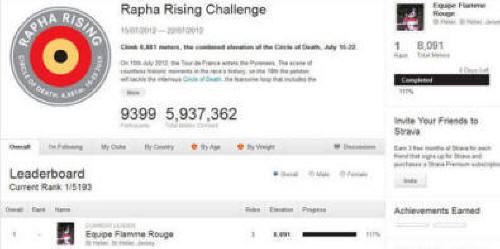
Believe me, there were times when the voices in my head nearly won. But it's the fact that I go around telling everyone what I'm going to do, before I do it, and the shame of not completing should I fail, that keeps me going when the "sensible thing" to do, would be, stop.
I use peer-induced shame as my "external stimulus". My perceived shame outweighs my real pain of continuing and my perceived pain of admitting failure to my peers.
And that's all you have to do. Find a way, your way, of turning that internal governor, or whatever it is, off. Or just find a way to distract or over-ride it long enough for it to give up complaining. Stop it, before it stops you.
Some people use music as an external distraction, but please, not on the open road. Just have faith in yourself, believe you can do it and you will. You just have to believe it enough.
Practical Applications
All of our sessions and programmes are designed (as should
any coach-led or self-developed training plan) to give you challenging
but sustainable progression. We do this by fooling the brain in to
believing what is and isn't achievable.
Most clients contact me after the first couple of sessions to ask "am I doing this right?" It seems too easy. I ask them to get back to me after the first 12 week macro cycle, and let me know if they still think it's easy!
If you try to do the Stingers before you've done the Tempo Ten's, I guarantee you'll fail, or fall short of your potential. You don't put a roof on a house until the walls are up. So don't try to boost your anaerobic roof before your aerobic walls are strong enough to take it.
Do the right things in the right order and slowly change your brains perspective of where the limits are.
You can't jump a chasm in two leaps, but you can build a bridge to the other side.
Slowly build a successful bridge to your objective. Don't crash and burn, thus confirming your sub-conscious negative expectations. Once you have "failed", the "event" has entered your consciousness. Your hurdle has just got immeasurably bigger!
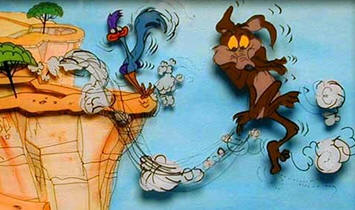
A perfect example of how to use this approach is for climbing a long hill that always seems to defeat you. When climbing, don't finish at the crest of the climb. If it finishes with a flat top section, ride a 100 metres past the top to a road sign or landmark. That's now the new finish line.
In week one, go easy at the bottom, easy in the middle, then go hard over the last third, and push all the way to the landmark. Success! Instant positive feedback and your objective (to hit the finish line strong) has been positively affirmed.
In week two go easy at the bottom, hard in the middle, harder for the last third and push for the line.
Week three? Go hard, harder, hardest, with the same high-end push to the finish. In week four, your adaptation week, recover and go "mildly-hard" all the way up, and clock that Strava PB.
For the following week, go and find a bigger hill and start the process all over again.
If you go hard from the bottom in week one, you'll just end up blowing before you get to the top and end up confirming your perceptions that it's not do-able. Your brain has convinced your body that you can't climb that hill at that speed. You're now on the back foot and on a possible slippery slope of overtraining.
It's the same with all the other training sessions you undertake. Creep up on the objective and silence the inner voice. Make them easy, complete them, then make them harder and harder and harder... Success will follow; how can it not?
At flamme rouge we've been using a session called The SHITS (Seriously Hard Interval Training Session) for around six years now. It works and it works well. The version on our website is a cut-down sample of how they work, although it still brings excellent results.
This year I changed the format of how we run them in our programmes; and the results have gone from great to staggering. In just three weeks it's possible for you to improve your short distance power output by five percent.
 This
"extra" power was found through changing the format and timing of the
sessions to mess with the mind. Or at least manipulating it to
believe the impossible was possible.
This
"extra" power was found through changing the format and timing of the
sessions to mess with the mind. Or at least manipulating it to
believe the impossible was possible.
We have deliberately confused the voices in your head by getting your body to perform a task before it realises it thinks it can't be done. Try to do the same with all of your future training sessions.
Don't listen to the voices. They're normal, but they're lying to you! They lie to everyone.
The Ten Second Distraction Trick
All you need to do, as you near the "inevitable end" of your
effort, be it a turbo session, hanging of the back of the bunch, or
banging out threshold power on an epic climb, is keep counting backwards
from ten! Just as you think you have to give in to the temptation
to stop, start counting backwards.
I guarantee that you'll probably count at least three times and will still be putting out the same effort. All you have to do is try and get to six counts of ten. If you do, you've won.
Once you've proved it works, you can use it all the time to distract yourself from the trolls inside your skull. You know there's 50% of your energy stores left, it's been proven by the white coats. You just need to find time to remind yourself. It only takes ten seconds...
As I was just putting the finishing touches to this factsheet I received an email from a rider I've been working with throughout the year. He's about to undertake one of the toughest events in the sportive world and wanted to validate his training before he went...
Thought I'd drop you a quick line with my self test result. Thought I should do this to see where we've got to after 3 months, as I didn't get chance to get out to Jersey. I tried to replicate the conditions as closely as possible to the first test I did.Actually I tried to do the test one day last week and also one day the week before, but failed on both occasions! Not sure why but I couldn't seem to sustain the effort level and bailed out after a couple of minutes each time.
But I had a very good ride this Saturday where I managed to push my heart rate up quite high on a few climbs and this gave me the confidence to try again today after a couple of days rest.
The results of the test confirmed a jump from 4.4 w/kg to 4.9 w/kg and a drop of 5 bpm heart rate. It was the confidence gained from the Saturday ride, and the experiential learning from the previous two "failures", that brought these excellent results.
Which just goes to show, there is no such thing as a failure in training. We're just learning something we didn't already know or finding something we can't yet do.
The Message
If you think you can, you can, if you think you can’t you’re right.
Don't listen to the inner voices; ever. Work on slowly pushing
back the boundaries, keep yourself cool, physically as well as mentally,
and never, ever, ever give up.
Even though the white coats don't quite know how it works, we get to experience what they're looking for every time we throw our legs over our bikes for another hammer fest that we hope will turn us in to the champion we believe is inside us.
Armed with the knowledge of this factsheet, we can now approach our training sessions, and every interval or hill within them, in a different light.
If nothing else we've determined that fatigue is an emotion, not a physical state of exhaustion! It's the champion that understands this better than most.
Your job is to think, and suffer, like a champion. It's only a matter of time before you become one.
Allow yourself to be part of the experiment. What's the worst that can happen?
Suffer well my friends, suffer well...
Thanks to Dave Young of
podfilms.tv for the video and Dr Shaun Philips,
University of Abertay
for
inspiring the subject of the factsheet








